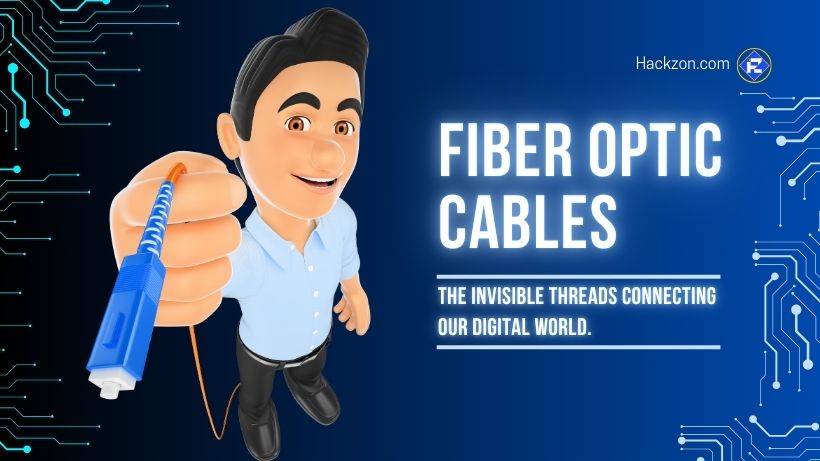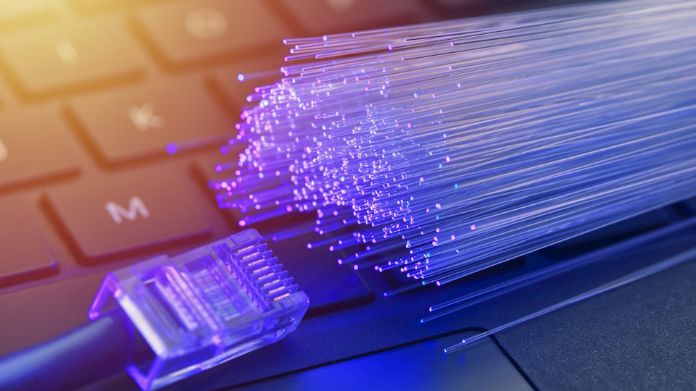Technology
How Fiber Optic Cables Transmit Data Over Long Distances
Discover how fiber optic cables transmit data across long distances using light signals, ensuring fast and reliable global communication. 🌍💡

Ever wondered how a video from all across the world could be streamed with hardly any lag? Fiber optic cables, the unseen foundation of international communication, hold the key to the solution.
Faster than you can blink, these technological wonders harness light to send enormous volumes of data across amazing distances.
In this guide, Hackzon will explain the intriguing physics of fiber optics and examine how these thin glass threads maintain global connectivity.
The Basics of Fiber Optic Cables
Fiber optic cables are advanced communication tools designed to transmit data in the form of light.
These cables consist of three main components:
- Core: The glass or plastic center where light travels.
- Cladding: An outer layer that ensures less signal loss by reflecting light back into the core.
- Protective Coating: Outer layers are designed to protect the delicate inner components from physical damage and environmental factors.
Fiber optic cables, unlike ordinary copper lines, convey data as light rather than electrical impulses.
Consider a lengthy glass tube operating as a highway for light beams—data goes quicker and with less interference than electrical signals through copper.
The Role of Light in Data Transmission
Fiber optic cables rely on light signals to transfer data. These signals are generated by lasers or LEDs, which convert electrical data into light pulses.
The key to their efficiency is the principle of total internal reflection, which keeps the light bouncing within the core without escaping.
Through this procedure, the data is guaranteed to arrive at its destination with little loss.
Each light pulse represents a piece of information, similar to how Morse code communicates through patterns.
Fiber optic technology is highly effective for contemporary communication because of its quick on-and-off signaling, which translates into high-speed data transport.
Why Fiber Optic Cables Are So Fast?

Fiber optic cables achieve incredible speeds thanks to the unique properties of light and advanced engineering.
Here’s why they outpace traditional data transmission methods:
- Speed of Light in Fiber: Data in fiber-optic cables travels as light, which moves at approximately 200,000 kilometers per second within the glass core. Although slightly slower than light in a vacuum, this is exponentially faster than the electrical signals used in copper wires.
- Minimal Signal Degradation: Compared to electrical lines, fiber optic cables suffer from far less signal loss. The principle of total internal reflection ensures that light signals maintain their strength over long distances, reducing the need for repeaters.
- Immune to Electromagnetic Interference: Unlike copper cables, fiber optics are unaffected by electromagnetic interference (EMI), which can distort electrical signals. This immunity ensures a clean and consistent signal, contributing to faster and more reliable data transmission.
- High Bandwidth Capacity: Fiber optic cables can carry vast amounts of data simultaneously. Technologies like wavelength-division multiplexing (WDM) allow multiple data streams to travel on different wavelengths of light within the same cable, greatly enhancing capacity.
- Advanced Signal Processing: Modern developments in fiber technology, such as denser fiber cores and enhanced transmission systems, have increased speed and efficiency. Data speeds of terabits per second are now possible because to innovations such as coherent optical transmission.
- No Crosstalk Issues: In copper wires, electrical signals from neighboring cables can interfere with each other, causing delays or errors. Fiber optics eliminate this issue entirely, allowing uninterrupted and ultra-fast data transmission.
These factors combined make fiber-optic cables the gold standard for high-speed communication, supporting everything from global internet networks to advanced scientific research.
Overcoming Long-Distance Challenges
Long-distance data transmission has drawbacks like signal loss or attenuation. Fiber optic technology gets beyond these obstacles by:
- Amplifiers: Devices placed at intervals to boost the light signals and maintain strength.
- Repeaters: Equipment that regenerates weakened signals for uninterrupted transmission.
- Wavelength-Division Multiplexing (WDM): A technique called wavelength-division multiplexing (WDM) divides light into several wavelengths so that more data may move at once.
Undersea cables, which connect continents, showcase the resilience of fiber optics. These cables, often thousands of miles long, are engineered to withstand extreme conditions while maintaining high-speed data transmission.
How Are Fiber Optic Cables Installed?
Installing fiber optic cables is a meticulous process that involves:
- Trenching: Laying cables underground or in protective ducts.
- Aerial Installation: Stringing cables along utility poles for above-ground networks.
- Undersea Deployment: Placing cables on the ocean floor using specialized ships.
Precision is crucial to protect the fragile fibers during installation. Before coming live, the cables are put through a rigorous testing process and splicing, which joins the fibers.
Benefits of Fiber Optic Technology
Fiber-optic technology offers numerous advantages:
- Faster Speeds: Compared to copper lines, light-based data transfer is far faster.
- Reliability: Resistance to interference ensures consistent performance.
- Energy Efficiency: Lower energy consumption compared to older systems.
Industries like healthcare, finance, and telecommunications rely heavily on fiber optics for tasks ranging from real-time data sharing to secure communication.
Everyday Applications of Fiber Optic Cables

Fiber optic technology powers many aspects of daily life:
- Telecommunications: High-speed internet and mobile networks.
- Medical Devices: Advanced imaging tools like endoscopes.
- Military Systems: Secure communication and targeting technologies.
- Broadcasting: Fiber optics are used to transmit high-definition television and live event feeds seamlessly.
- Data Centers: Fiber optics enable fast and efficient data transfers between servers, ensuring smooth cloud computing operations.
- Retail and Payment Systems: Many point-of-sale systems rely on fiber optics for secure and rapid transaction processing.
- Smart Cities: Fiber-optic networks support IoT devices, traffic management systems, and city-wide surveillance.
- Gaming: The low latency of fiber optics provides an optimal experience for online gaming.
- Education: Universities and schools use fiber optics for virtual classrooms, video conferencing, and e-learning platforms.
- Industrial Automation: Fiber optics facilitate precise control and monitoring in manufacturing processes.
Even seemingly mundane uses, such as decorative lighting and sensors, benefit from fiber-optic innovation.
The versatility of this technology continues to expand its applications in both specialized industries and everyday life.
The Future of Fiber Optics
As data demands grow, fiber-optic technology continues to evolve. Emerging trends include:
- Quantum Communication: Ultra-secure data transmission methods.
- Terabit-Speed Networks: Infrastructure that enables even greater data rates.
- Self-Healing Cables: These are innovations that automatically repair minor damages.
Fiber optics may also integrate with satellite systems, expanding connectivity to remote areas and improving global communication networks.
Our Thoughts
Fiber optic technology has become a cornerstone of modern communication, enabling faster and more reliable data transmission than ever before.
From connecting continents to powering everyday internet use, its applications are vast and transformative.
Fiber optics will surely be crucial in determining how connection develops in the future as innovation propels technological advancement.
Our digital world will continue to grow at the speed of light because of the limitless possibilities.
















